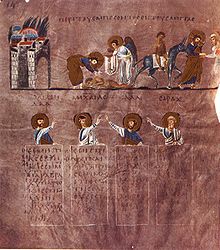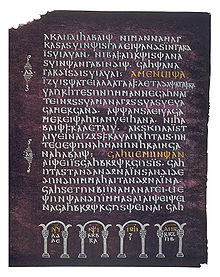Purple parchment


Purple parchment, Purple vellum or Codex Purpureus refers to manuscripts written on parchment (actually always vellum, the higher quality version) dyed purple. This was at one point supposedly restricted for the use of Roman or Byzantine Emperors, although in a letter of Saint Jerome of 384, he "writes scornfully of the wealthy Christian women whose books are written in gold on purple vellum, and clothed with gems...".[1] The lettering may be in gold or silver. Later the practice was revived for some especially grand illuminated manuscripts produced for the Emperors in Carolingian art and Ottonian art, in Anglo-Saxon England and elsewhere. Some just use purple parchment for sections of the work; the 8th century Anglo-Saxon Stockholm Codex Aureus alternates dyed and un-dyed pages.
Examples
The Purple Uncials or the Purple Codices is a well known group of these manuscripts, all 6th century New Testament Greek manuscripts:
- Codex Purpureus Petropolitanus N (022)
- Sinope Gospels O (023) (illuminated)
- Rossano Gospels Σ (042) (illuminated)
- Codex Beratinus Φ (043) (illuminated)
- Uncial 080
Two other purple New Testament Greek manuscripts are minuscules:
- Minuscule 565 known as the Empress Theodora's Codex
- Minuscule 1143 known as Beratinus 2
There is a 9th-century lectionary:
- Codex Neapolitanus, former Codex Vindobonensis 2
Another six New Testament purple manuscripts are in Latin (a, b, e, f, i, j). Besides some scattered fragments, they are held mainly in: Brescia, Naples, Sarezzano, Trent and Vienna. Three of these use Vetus Latina texts.
- Codex Vercellensis
- Codex Veronensis
- Codex Palatinus
- Codex Brixianus
- Codex Purpureus Sarzanensis
- Codex Vindobonensis Lat. 1235
There is also one Gothic purple codex — Codex Argenteus (illuminated)
There is a purple manuscript of part of the Septuagint:
- Vienna Genesis (illuminated)
Other illuminated manuscripts include the Godescalc Evangelistary of 781-3, the Vienna Coronation Gospels (early 9th century) and a few pages of the 9th century La Cava Bible from the Kingdom of Asturias. Anglo-Saxon examples include a lost 7th century Gospels commissioned by Saint Wilfrid.
See also
![]() Media related to Purple parchments at Wikimedia Commons
Media related to Purple parchments at Wikimedia Commons
Notes
- ^ Needham, 21
References
- Needham, Paul (1979). Twelve Centuries of Bookbindings 400–1600. Pierpoint Morgan Library/Oxford University Press. ISBN 978-0-192-11580-5.
